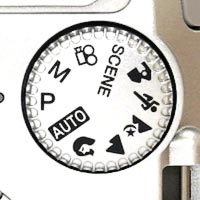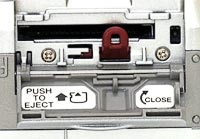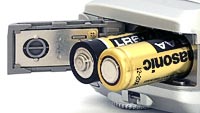Olympus C-500 Zoom
Review Date: May 5th 2005
|
Ease of Use
The Olympus C-500 Zoom is not what you would call a good looking digital camera. It is best described as "boxy", with a chunky angular handgrip and a mixture of curved and angled corners. The Olympus C-500 Zoom is also quite large for this class of camera, and whilst it is still pocketable, other competitive products offer a similar specification in a smaller package. Thankfully the layout of the external controls on this camera is well thought out, and because it is slightly larger than usual, the Olympus C-500 Zoom doesn't feel cramped. The angular handgrip means that holding the camera in either one hand or two is equally comfortable. The Olympus C-500 Zoom is constructed entirely of plastic with a shiny silver finish - my review sample was showing a few scratch and scuff marks. There is also a thick grey metal band that runs around both sides and the top of the camera, presumably there to help keep the overall design rigid and stop it from flexing.
The Olympus C-500 Zoom strikes the right balance in terms of the number of external controls on the camera, with 10 in total, perfect for its target audience. There are just enough to give you full control over the important aspects of the Olympus C-500 Zoom, but not so many that you're left wondering which one does what. The Olympus C-500 Zoom instantly feels intuitive to hold and use. There's a traditional dial on the rear of the camera that lets you select the different exposure modes; Auto, Manual, the various Scene modes and the Movie mode. This dial is a typical feature of SLR cameras, and enables you to quickly change between the various modes. The Olympus engineers have put it in a strange place though - just underneath and to the right of the zoom buttons - which can be a little irritating when you're composing a photo. There is quite a lot of empty space on the rear of the camera where this dial would have been better located.
All other buttons and controls are straight-forward to use for anyone who has picked up a digital camera before. There is nothing particularly innovative, so there is nothing to potentially confuse. Olympus had added a large, tactile shutter release button, and all the various covers and lids are well-finished and durable. Even the tripod mount, although made of plastic, is well-located.
| Exposure Mode Dial | Power Button |
 |
 |
The menu system of the Olympus C-500 Zoom is fairly well designed. Pressing the OK button in the middle of the arrow pad accesses the menu options. Depending on which shooting mode you are currently using, these include setting the image quality, self-timer, turning the LCD monitor on or off and a sub-menu called the Mode Menu, which contains settings like the metering mode, ISO speed and formatting the memory card. It would have been good if some of the more common options (such as ISO speed and metering mode) were also accessible via a button.
The four corners of the arrow pad act as directional buttons, allowing you to scroll through images and the menu system, but they also have their own specific functions as well when you select the Progamme AE and Manual shooting modes. In Progamme AE mode, the left and right buttons change exposure compensation. In Manual mode, the left and right buttons change the aperture whilst the up and down buttons change the shutter speed. Whilst the Olympus C-500 Zoom offers a range of shutter speeds from 15 seconds to 1/200th sec., it isn't quite so generous when it comes to apertures. There are only ever 2 choices, for example f/2.8 or f/4 when the lens is at its widest setting, and f/4.9 or f/7.0 at the telephoto setting. Still, at least it gives you some control over the creative aspect of photography. To help you get the exposure right, in the top-right corner of the LCD display is a number indicating how far under or over exposed the image will be using the current settings - this needs to be 0 to achieve the perfect exposure (as metered by the camera).
| Memory Card Slot | Battery Compartment |
 |
 |
The start-up time of the Olympus C-500 Zoom, from turning the camera on to being ready to take a photo, is fairly quick at around 2 seconds. The 3x zoom lens takes around 1.5 seconds to zoom from the widest focal length to the longest, but the zooming mechanism is quite noisy, which doesn't make the Olympus C-500 Zoom particularly suitable for candid photography. Focusing is quick in good light and competent enough indoors or in low-light situations, although it takes longer to lock on to the subject at the telephoto lens setting than wide-angle. Shutter-lag is barely noticeable but storing an image is not very quick at around 1 second. The 1.8 inch LCD screen is bright and clear and the refresh rate is fine. The Olympus C-500 Zoom has a limited range of continuous shooting modes and a slow maximum shooting rate of 1.2 fps for up to 5 frames, which doesn't make it particularly well suited for fast moving subjects. All in all the Olympus C-500 Zoom is fairly responsive in terms of its general operational speed.
Once you have captured a photo, the Olympus C-500 Zoom has an average range of options for playing, reviewing and managing your images. You can scroll through the images that you have taken, view thumbnails, zoom in and out up to a magnification of 5x, and view fairly detailed information about each image. You can also add an audio clip to each image, delete an image, rotate an image, lock images so that they cannot be deleted, and set various printing options. There are also a few digital effects available. The Edit menu contains 4 different options that you can apply to a recorded image - Add Frame, Black and White, Sepia and Resize. The camera shows you a preview of what the effect will look like when applied, and importantly the effect is applied to a copy of your image, thus preserving the original intact. The most important missing feature is a histogram (both before taking a photo and after) which would be a great help in evaluating the exposure.
Overall the Olympus C-500 Zoom is a simple to use and well-built digital camera that is ideally suited to photography of slow-moving subjects.
|
 PhotographyBLOG is a member of the DIWA organisation. Our test results for the Olympus C-500 Zoom have been submitted to DIWA for comparison with test results for different samples of the same camera model supplied by other DIWA member sites.
PhotographyBLOG is a member of the DIWA organisation. Our test results for the Olympus C-500 Zoom have been submitted to DIWA for comparison with test results for different samples of the same camera model supplied by other DIWA member sites.
